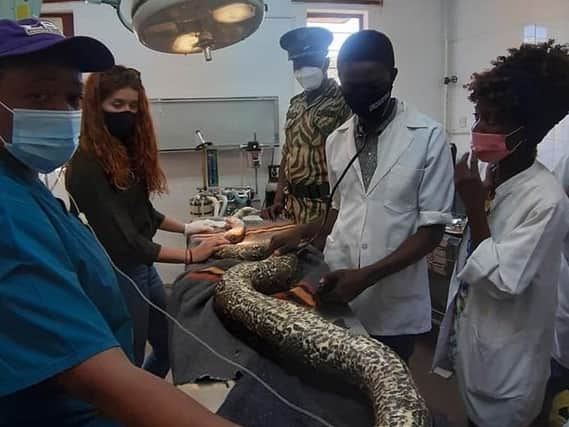How to put a bandage on a four-metre python! Lauren's adventures in Africa


I am Lauren Macneil a British 22-year-old living in Zambia and working for a wildlife rescue sanctuary.
This column will keep you up to date on my adventures.
Why Africa? Aged nine I decided I was going to live in Africa and proceeded to inform everyone I met. At 18 I took a voluntary position at Kasanka National Park for six months – one of the best experiences of my life.


Advertisement
Hide AdAdvertisement
Hide AdI graduated in zoology from the University of Exeter. Then I was given the name Bruce Woods. He was running a wildlife sanctuary in Zambia’s capital – entirely on his own – and needed an extra pair of hands...
Our plan is to build Zambia’s first wildlife hospital on an existing wildlife park, taking over the control of four young lions and the remaining animal enclosures there.
We’ll then build satellite hospitals in surrounding countries and parts of Zambia, to fill the void in wildlife rehabilitation here in southern Africa.
Our aim is to also work in combating wildlife trafficking into the pet trade.


Advertisement
Hide AdAdvertisement
Hide AdAt the sanctuary we welcome animals of any species and receive calls 24/7 from around the country – there really is no one else rehabilitating wild animals back to release in the wild.
As Brits we have very limited experience with dangerous wildlife so the learning curve for me has been steep. Within two weeks of arriving, I was bandaging a completely unanaesthetised 4m African rock python, and regularly hand feeding a fish eagle.
For me this opportunity to work with such a variety of wildlife has been amazing. We currently have owls, birds of prey, pythons, monkeys and genets regularly staying with us until their release.
Sadly, in Africa there is stigma surrounding certain species, with owls and snakes in particular being associated with witchcraft.
Advertisement
Hide AdAdvertisement
Hide AdIt’s not uncommon for these animals to be attacked, and many of our rescues are now partially blind.
We’re not only taking in those animals that need us but educating far and wide on the importance of conservation and removing the fear of wildlife.
We are improving the interaction between wild animals and people, a longstanding issue here in Africa.
The enclosures for our animals are next to a farmhouse we occupy while we wait to move, with the more fragile rescues being inside.
Advertisement
Hide AdAdvertisement
Hide AdThis leads to some rather interesting sights – one being my boss having a long-winded argument with a large male vervet monkey on why he needs a bath and having to sit fully clothed in the water with him to prove how safe it was.
I also get to play ‘find Bob’ most hours of the day, as this tiny white-faced scopes owl (pictured) is living in my room due the huge number of rescues we’ve received in the last couple of weeks.
He has an uncanny ability for hiding among my clothes. He also believes he is the scariest animal we have and will puff up his feathers and run at you from across the room.
As he’s recovering from being stoned out of a tree and damaging his wing, he needs the space to rebuild his strength.
Advertisement
Hide AdAdvertisement
Hide AdBut with his energy levels it does result in him recreating the ninja warrior assault course around my bedroom at about 2am.
Find out more about A Different Wild Rehabilitation Sanctuary here
To support the wildlife hospital plan see Lauren's fundraising page here
On Instagram, follow angwa_conservation or follow Lauren at offonwalkabout